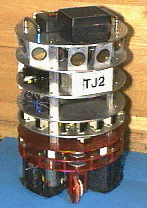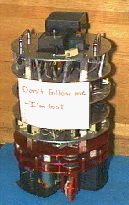
|
Retired Robots
|
||
 |
||

 (It says "Don't follow me... I'm lost")
(It says "Don't follow me... I'm lost")
This project aims to make it easy for people to communicate with navigating indoor office-based mobile robots by providing a bridge between (1) the kind of language people use to name places and describe paths among them, and (2) the radically different way existing mobile robots conceive of the world due to their impoverished sensory capabilities.
This project was completed as part of Mark Torrance's Master's Thesis at the MIT Artificial Intelligence Lab. For more information please consult the publications below.
- Where are you?
- I don't know where I am right now.
- Which way are you facing?
- I don't know which way I am facing. Please tell me.
- You are facing north
- I am facing NORTH. Thanks.
- You are at Mark's office
- I'm learning about MARK'S OFFICE.
- Turn around
- I'm turning around.
- Go until you can turn right
- I'm going until I see no obstacle on the right.
- You are at the northeast entrance to the elevator lobby
- I'm learning about THE NORTHEAST ENTRANCE TO THE ELEVATOR LOBBY.
- Go
- I'm going.
- Stop
- I'm stopping.
- You are at Jim's office
- I'm learning about JIM'S OFFICE.
- How do you get from Jim's office to Mark's office?
- To get from JIM'S OFFICE to MARK'S OFFICE,
In the ROP, I face NORTH and go 8.2 feet.
In the ROP, I face NORTH and go 13.6 feet.
- Karen's office is north of Jim's office.
- I'm learning about KAREN'S OFFICE.
- Go to Mark's office
- Now I'm going from JIM'S OFFICE to THE NORTHEAST ENTRANCE TO THE ELEVATOR LOBBY.
Would you please tell me if I pass KAREN'S OFFICE.
This is THE NORTHEAST ENTRANCE TO THE ELEVATOR LOBBY.
Now I'm going from THE NORTHEAST ENTRANCE TO THE ELEVATOR LOBBY to MARK'S OFFICE.
This is MARK'S OFFICE.
I have arrived at MARK'S OFFICE.
- Go to Karen's office.
- I don't know how to get to KAREN'S OFFICE from here.
- Go to Jim's office.
- Now I'm going from MARK'S OFFICE to THE NORTHEAST ENTRANCE TO THE ELEVATOR LOBBY.
This is THE NORTHEAST ENTRANCE TO THE ELEVATOR LOBBY.
Now I'm going from THE NORTHEAST ENTRANCE TO THE ELEVATOR LOBBY to JIM'S OFFICE.
This is JIM'S OFFICE.
I have arrived at JIM'S OFFICE.
In addition to the language exercised above (and related capacities not explicitly used here), the robot can also face named directions, accept arbitrary names for places, and answer questions about where places are in terms of their adjacent places.
Mark C. Torrance, <torrance@ai.mit.edu>